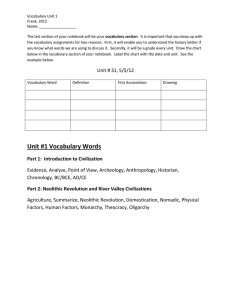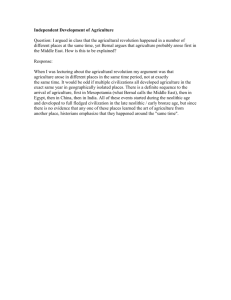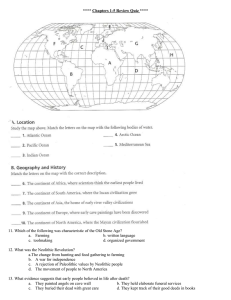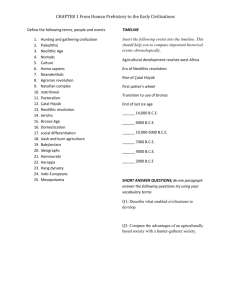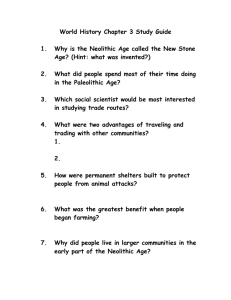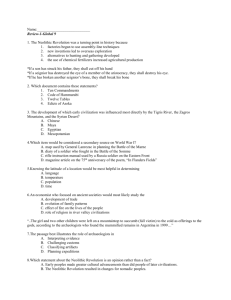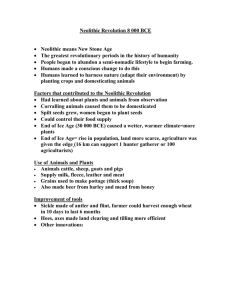The agricultural revolution Its causes and consequences
advertisement
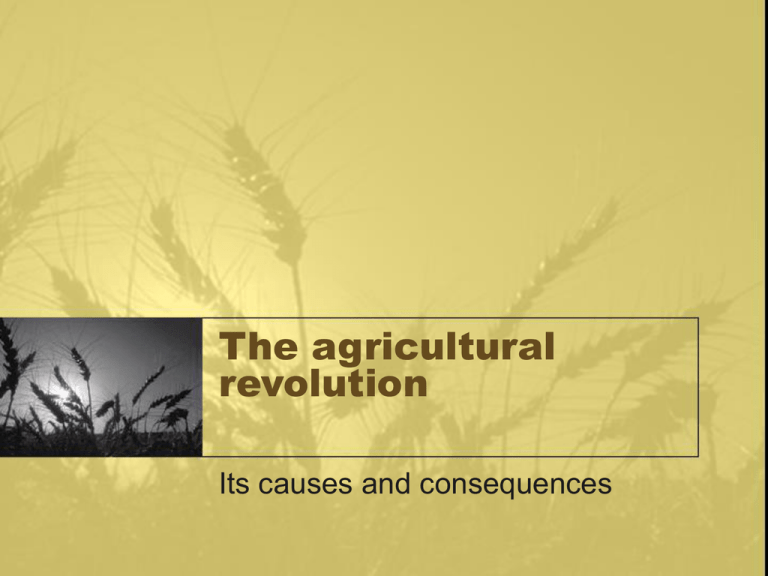
The agricultural revolution Its causes and consequences The neolithic revolution • Neolithic=new stone age, associated with the rise of intensive agricultural practises, i.e. farming with the use of the plough and irrigation, as well as domesticated plants and animals. • First evidence for farming is found in the highland areas of Mesopotamia about c. 14,000 b.p. (barley). • Intensive agriculture is much more productive than hfg, but is also much more labour-intensive. (remember: hfg must work about 2-4 days per week only, even in marginal environments). • Consequences of food production are very well known, although its initial causes are still being debated (Weisdorf). • Clear that once agricultural production had taken hold, population increases meant that a large-scale return to hunting and food gathering would be impossible. The main consequences of agricultural production • Populations became more sedentary and worked longer hours. • Production of a social surplus, due to the fact that each household can produce about 5 times its own necessary consumption. • Increased population and fertility, due to sedentarism, increased food supply, and the decline of birth-spacing. • Emergence of towns, and later cities. The urban revolution closely followed the neolithic revolution. • Emergence of full-time specialists not dependent on farming, e.g. craftsmen, such as metal workers, potters, weavers, and also priests, scribes, artists, bureaucrats, and aristocrats, law-makers, traders. • Stimulated inventions in: metallurgy, writing, astronomy, architecture, city-planning. • Also: increase in infectious diseases: smallpox, measles, influenza, tuberculosis, malaria. First Cities • Date back to 8000 to 7000 BCE • Jericho—west bank of Jordon River • Catal Huyuk—in Turkey • Danpo—China • Harrappa-Pakistan. • Became more common after 4000-3000 BCE • Jericho’s Walls The neolithic revolution and social inequality • • • • Early stages of the neolithic revolution show evidence of specialists, but not major social inequalities: all had access to food and land through kinship networks. Some archeologists think that inequality first emerged through differences in soil fertility between river valleys and more mountainous areas: e.g. Indus River Valley, referred to as centre-place theory. In the ‘fertile crescent’, as city-states competed with each other for land, warfare emerged, accompanied by the enslavement of captured populations, usually women. (Mesopotamia, about 3,000 bp). Slavery and inequality were later legally instituted through Mesopotamian law codes, e.g. the middle Assyrian law code c. 2500 bc and the Hammurabic code, c. 1750 bc. Domestic slavery also recognized in these codes, as some women from poorer families were sold into domestic slavery. Origin of veiling: (MALC): – • "Neither wives of seignoirs nor widors who go out on the street may have their heads undovered. These women...must veil themselves with either a shawl or robe or mantle if they go out on the street alone. A concubine who goes out on the street with her mistress must veil herself. A sacred prostitute whom a man married must veil herself on the street, but one whom a man did not marry must have her head uncovered on the street; she must not veil herself. A harlot must not veil herself; her head must be uncovered.” Warfare also led to the emergence of permanent, centralized bureaucratic institutions, led first by priests. These are known as ‘states’. States and territories. • • • From kinship based communities to territory based ‘empires’ and ‘nations’. Chieftainships (rank-based) to state (class-based) societies. Functions of the state: • • • • law and order maintains socioeconomic contrasts suppression of internal disorder defense against external threats Centres of neolithic cultures • Most agree with Childe and Flannery that the neolithic revolution started first in the mountainous regions of Mesopotamia, i.e. the region of contemporary Iraq near the Tigris and Euphrates rivers. • However, French archeologists in Vietnam claim that the Hoabinhian culture began food production about 14,000 bp also. Also, the Nile Valley has mortar and pestles from 15,000 bp, but these sites were later abandoned. • The major centres of early food production include: Baluchistan (Pakistan) 8,000 bp, northern China, the Nile Valley, and Central America. Neolithic started 10,000 bp Indus River Valley Map Neolithic started c. 7,000 bp Gender, family and territory • In horticultural and hfg societies, there are many example of matrilineal societies, i.e. those in which descent is traced through the mother. – Women often have important ritual and political roles if they control valued goods, e.g. the Iroquois. • • Gradual change from matrilineal to patrilineal descent groups with intensive agriculture. Land is inherited by males, women receive dowry as family property. Plough agriculture nearly everywhere is exclusively male. – Separation of the domestic realm from the realm of production, with women being associated with domestic duties and men with farming, politics, law. • • Status of women declined after the emergence of the state. Law codes differentiate in terms of status and gender:, e.g. the middle assyrian law code and the hammurabic code. Extended family units become the main unit of production; reciprocity between family units declines and state takes over the task of redistributing goods.
